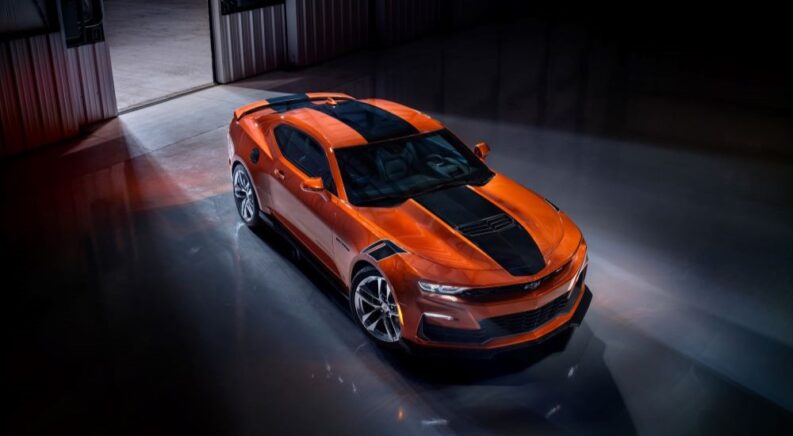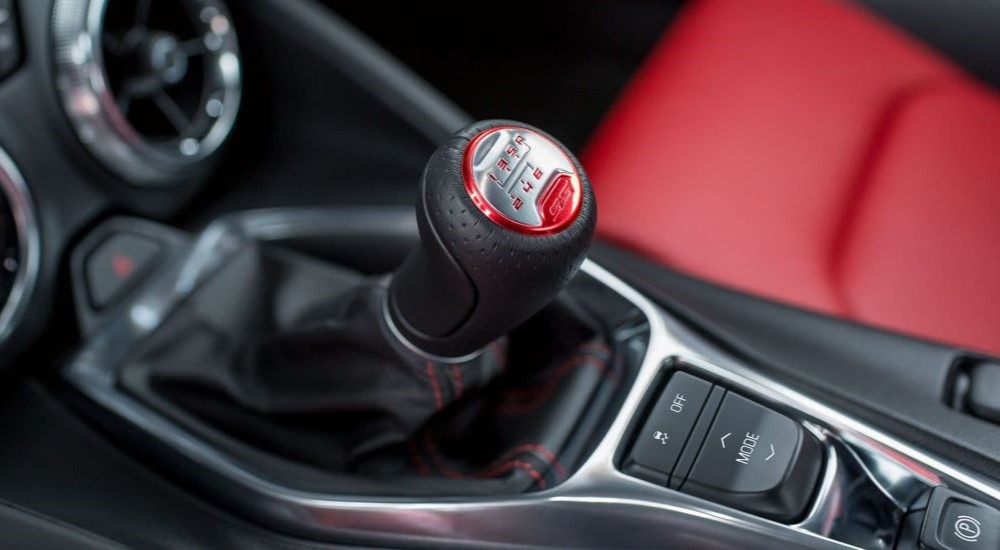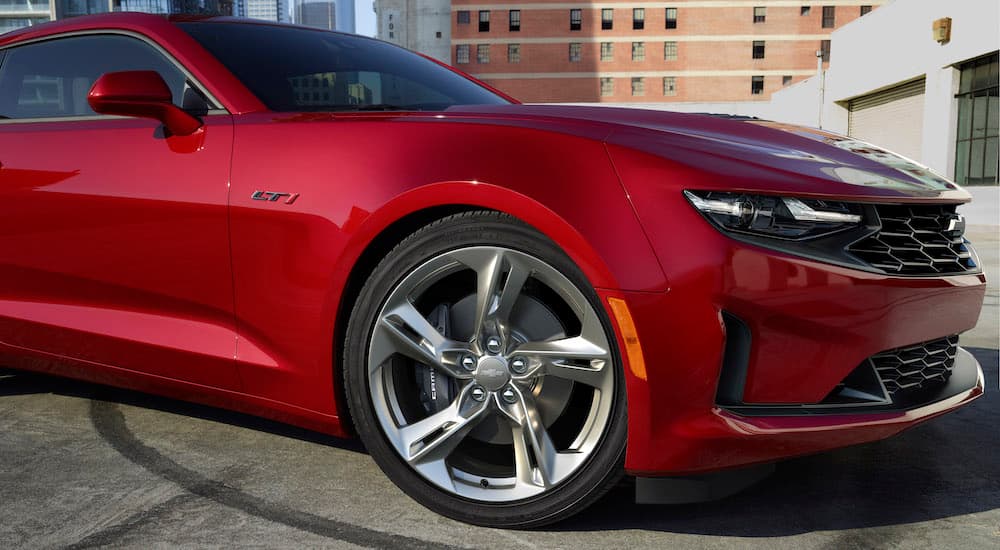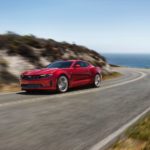It’s been more than half a century since the Chevy Camaro burst onto the scene with all the swagger, bravado, and ill intent of the villain in a superhero blockbuster. Ford had spoiled Chevy’s prevailing industry dominance with the revolutionary Mustang in 1964, but Chevy couldn’t let the blue oval have an entire market niche to themselves. Thus, the Camaro—named for a “small and vicious creature that eats Mustangs”—was introduced in 1966 to take America’s pony car down a peg.
The 2023 Chevy Camaro continues the long tradition of existing almost entirely to spite the Mustang. However, ever since the crises of the 1970s that killed the Challenger and transformed the Mustang, the Camaro—which remained loud and bold throughout—earned its own identity as the most authentic pony car on the market. It makes a serious appeal to vanity with its aggressive profile, hundreds of styling combinations, and four remarkable engines. It also makes a strong appeal to die-hards with its remarkable chassis, turning this “people’s sports car” into a bonafide supercar-killing track weapon.
Few cars offer so many unique designs; fewer still can offer such distinct builds for less than $50,000. Today, I’m taking a look at some of the ways the Camaro does just that, depending on whether the aspirant driver is prioritizing the engine choice, the suspension equipment, or the tech and styling loadout above all else. However, I must lead with the disclaimer that dealer markups and supply shortages will influence the real-world mileage of these builds. So, without further adieu, here are some of the most exciting ways to build out a 2023 Chevy Camaro.
Priority: Engine
There are two true choices if the engine is your top priority: a turbo-charged 4-cylinder or a V8. I have nothing against the V6, but it compromises on the more extreme options and seems a better choice for someone whose top priority is not the engine (more on that later).
Let’s start with the most efficient and economical of the Camaro engines. It may seem antithetical to care about a pony car’s efficiency, but a few key truths about the turbo-charged 2.0L four-cylinder engine must be acknowledged. First, it offers the cheapest pathway to Camaro ownership. Secondly, it is 10% more efficient than the V6. Finally, it still produces 275 hp and 295 lb-ft of torque.
The result is a vehicle that can be thoroughly enjoyed on the road without risking jail time and without funneling your paycheck straight into the fuel tank. For somebody who wants a fun ride they can whip out on a daily basis, the Turbo I-4 that comes standard on LS and LT trims is a winner! Plus, if you’re approaching a Camaro with a $50,000 budget, the four-cylinder leaves the most room for splurging on design and tech features. It’s almost hard to build a turbo Camaro with that kind of MSRP!
Most enthusiasts, however, will be daydreaming of the V8—and for good reason. The 6.2L LT1 V8 engine produces a lecherous roar and yields more power than Chevy could have dreamed of producing back in 1966. It has an entire Malibu’s worth of extra power and torque against the Turbo I-4, for a whopping 455 hp and 455 lb-ft!
Of course, the V8 comes at a price: it’s a $10,000 upgrade from the base LS and, depending on where you land across LT1 and SS trims, there could be very little wiggle room for personalization on a $50k budget. The supercharged ZL1 starts at more than $68,000—far above our thought experiment’s limits—but if your take on the Camaro is V8-or-bust, this will be the engine for you; and the mostly-standard car you’ve built around it will still be satisfying.
Priority: Suspension
If you’re in love with the Camaro for its class-leading chassis, you’re not alone. The current Camaro shares its architecture with the now-defunct Cadillac ATS, a car designed to challenge the BMW 3-Series and the planted, communicative way it navigates curves is unrecognizable from the unwieldy muscle cars that preceded it. Today’s Camaro is fully capable of supercar-level performance and drivers in pursuit of this kind of precision—should they also be considering a cooler MX-5 or a cheaper Corvette—will invariably want to equip the 1LE performance package.
In 2023, one must leap up to the SS trim to access the 1LE track performance package, and there you’ll encounter a fork in the road. The full package is a $7,000 option available in the coupe configuration, which fits our $50,000 budget, should you take 1SS trim. Otherwise you’ll have to settle for the 1LE Spec Suspension Package, which keeps Magnetic Ride Shock calibration and stiffer springs and sway bars while allowing the upgrade to 2SS trim within the bounds of today’s thought experiment.
Both packages have their benefits. If you value luxury tech features highly enough that the 2SS trim is a must-have, then the suspension package is your best means of attaining higher performance without going over-budget.
If you can forego heated seats—and I suspect you can, if suspension and handling truly is your top priority—the 1SS trim with the SS 1LE track performance package should be your pick. It’ll cost a pretty penny but it’ll make for an unparalleled ride, with enhanced suspension components like Goodyear Eagle F1 SuperCar tires, 6-piston Brembo antilock brakes, dual-mode exhaust, and an electronic limited-slip differential—a real one, not a duplicitous simulated substitute!
The best part? After equipping this suspension to your V8-powered 1SS Camaro, you can still choose between an automatic transmission, ambient lighting, and a performance data recorder without maxing out the budget. Oh, how to choose…
Priority: Aesthetic
It’s entirely possible that your love for the Camaro is more about style than anything else. In this case, you’re in luck. With a $50,000 budget, we can throw the kitchen sink at any Camaro under the SS trim level and easily max out all the features and accents available. We’re looking first at the 3LT and LT1, whose primary difference is the engine offered—either the Turbo I-4 or the V6 for the 3LT or the V8 in the LT1—or, at least, that’s how it appears on the surface.
That’s because, with the wiggle room of a few extra thousand dollars in our thought experiment, the 3LT allows for more personalization while hosting a longer list of standard features. I’d start the build by making it a convertible with the V6 and an automatic transmission; then we can add paddle shifters and a remote start. I’d later tack on the dual-mode exhaust to make the most of my engine choice. Next, I’d make it a Shock and Steel Special Edition, which includes the RS appearance package and a swathe of cosmetic upgrades inside and out. I’d round out the build by adding lighting features and red accents wherever I can, equipping every bell and whistle that doesn’t already come standard.
What does LT1 offer besides the V8 to top that? Well, there’s the Brembos, vividly painted to broadcast their presence. I would definitely opt for the Bose premium sound system and the ambient lighting here—and the comfortable heated seats aren’t even optional! It does offer a windscreen air deflector in convertible guise and a handful of lighting and accent options before we hit the $50k ceiling, but that’s about all… so, if the LT1 is your pick, I hope the V8 rumble is worth it!
There are two other feature-focused builds to consider, which compromise a little depending on whether you’re leaning more toward appearance or technology. The 1LT Camaro sheds a bit of technology like the HUD and heated seats, but you can kit that sucker out with everything for less than $50k—Recaro buckets, Brembo front brakes, the highfalutin-Design Package 3, dual-mode exhaust, and nearly every cosmetic option on the list, from illuminated bowtie emblems to red seatbelts. The result is a meaner-looking exterior than the Shock and Steel 3LT, at the expense of some interior features—perfect should you believe it’s what’s on the outside that counts.
On the other hand, one could lean into racing tech and insist on having the Performance Data Recorder. If this is the case, there is one pathway to building this for less than $50k: the 1SS 1LE with a manual transmission and the PDR option selected. You can still choose your preferred paint color and one other non-illuminated cosmetic adjustment before maxing out the budget, but that’s it! That’s okay, however, as the mean SS front fascia atones for the inflexibility of the build.
The People’s Sports Car
Pony car, muscle car, track weapon, supercar killer—the Camaro’s been called a lot of things over the years. It would be insensible to suggest that a $50,000 budget is feasible to the average driver, and I must acknowledge that supply issues and dealer markups can wreak havoc on the best-laid of build plans. However, as far as thought experiments go, I think I’ve shown that the Camaro offers a huge canvas at a great price. We’ve covered 15 different ways to approach a unique $50k Camaro build based on different priorities and have barely scratched the surface of how distinct they can be!
Take it as a sign that, five to ten years from now, when 2023 Camaros are familiar to the preowned market, there will be a vast diversity of builds to pick through. Whether these builds fit your budget today or—for those like myself—after a decade of depreciation, the Camaro remains a bold and exciting sports car for the masses. Just wait ’til they make an SUV of it.






